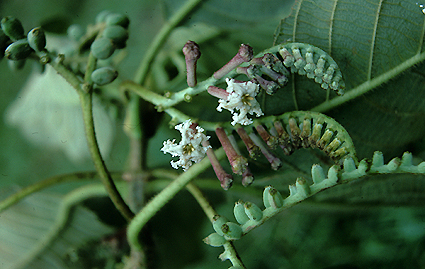Rubiaceae of the New World
By Piero Delprete and
Rocio Cortés
GUETTARDA Linnaeus
Rubiaceae of the New World
By Piero Delprete and
Rocio Cortés
GUETTARDA Linnaeus

Guettarda crispiflora Photo P. Delprete Maquipucuna Reserve, Pichincha, Ecuador |
Synonyms: Cadamba Sonnerat; Dicrobotryum Willdenow ex J. A. Schultes in J. J. Roemer & J. A. Schultes; Donkelaaria Lemaire; Edechia Loefling; Halesia P. Browne, non Halesia J. Ellis ex Linnaeus; Laugeria Linnaeus (orth. var.), Laugieria Jacquin; Mathiola Scopoli (orth. var.), non Mathiola R. Brown, Matthiola Linnaeus, non Matthiola R. Brown; Sardinia Vellozo; Tournefortiopsis Rusby
Shrubs or small, medium-sized to tall trees; raphides absent; axillary thorns absent. Stipules interpetiolar, free at base or intrapetiolar, narrowly triangular or deltoid, persistent or readily caducous. Leaves opposite or whorled, 3 or 4 per node, long- to short-petiolate; blades ovate, elliptic or oblong, membranaceous or thinly coriaceous; foliar pellucid glands absent; domatia hairy-pockets or absent. Inflorescence axillary, cymose, commonly with scorpioid branches, pauciflorous or multiflorous. Flowers bisexual, or unisexual and bisexual on the same individual (polygamous-dioecious), protandrous. Calyx cup-shaped, with small lobes, persistent; lobes 2 to 9, deltoid, broadly triangular or ovate, minute or small. Calycophylls absent. Corolla hypocrateriform or broadly infundibuliform, actinomorphic, white to cream-white, yellow, violet, purple or bluish-white to pale blue; tube externally pubescent, internally glabrous or pubescent, with or without a pubescent ring at base inside; orifice annular thickening absent; lobes 4 to 9, valvate or imbricate (tube non reduplicate), ovate, rounded or oblong, margin entire, undulate or frindged, rounded at apex. Stamens alternate to the corolla lobes, included, anthers oblong or linear, acute at base, acute at apex, dehiscing by longitudinal slits, dorsifixed near the base; filaments attached near the mouth of the corolla tube, free at base, filiform, short (anthers subsessil), equal, glabrous. Style included, filiform throughout, glabrous or antrorse-puberulent. Ovary inferior, 2- to 9-locular, globose; placentation axile, ovules pendulous, 1 per locule. Fruit drupaceous, fleshy. Seeds pendulous.
Geographic distribution: Northern Central America (up to southern Mexico), southern Central America, northern Chocó area, southern Chocó area, West Indies, Magdalena-Llanos area, Napo-Marañón drainage, southwestern Amazon Basin, western Amazon Basin, Guayana Shield, central Amazon basin, eastern Amazon basin, northeastern Brazil, Brazilian Atlantic coast, Brazilian planalto, Rio Paraná drainage, northern Andes (above 1000 m), central Andes, southern intertropical Andes, extra-tropical North America. A pantropical genus of about 180 species.
Number of species: 139.